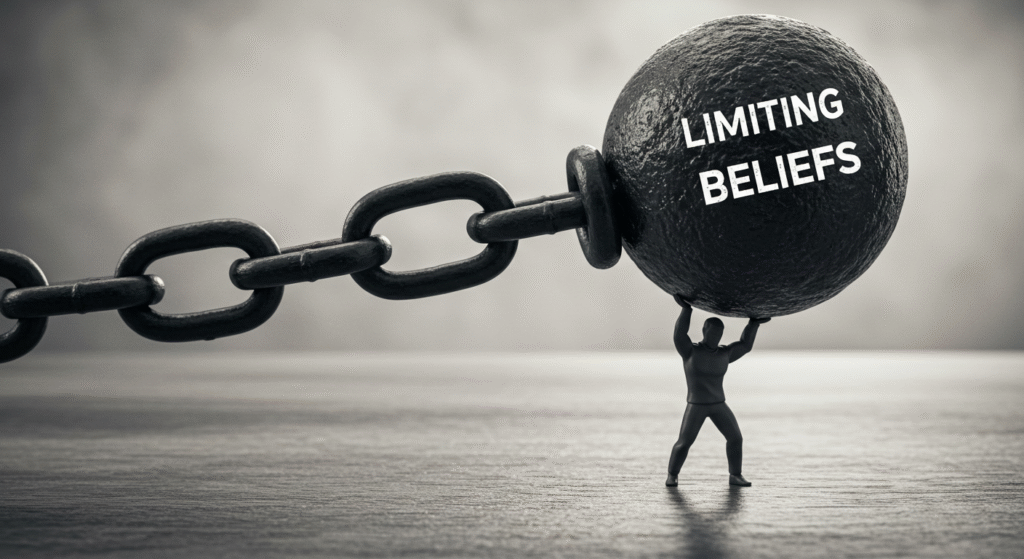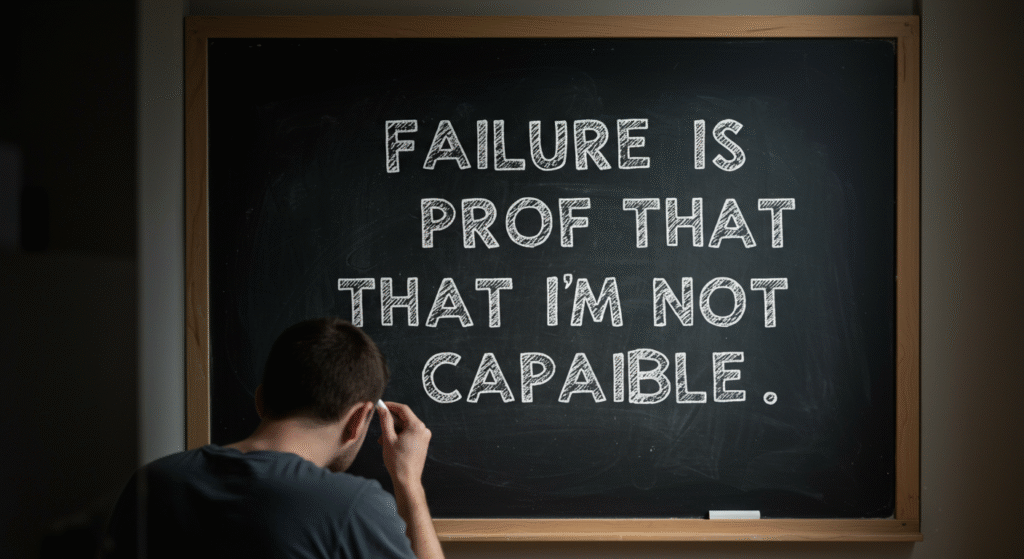Limiting beliefs are sneaky obstacles we often don’t realize are holding us back. These mental blocks shape how we view ourselves, what we think we can achieve, and the risks we’re willing to take. Identifying and overcoming them can unlock doors to personal growth, success, and happiness.
This comprehensive guide will help you pinpoint these beliefs in your life and provide actionable strategies to overcome them.
Table of Contents
- What Are Limiting Beliefs?
- Common Examples of Limiting Beliefs
- How Limiting Beliefs Develop
- Signs That You’re Being Held Back
- The Impact of Limiting Beliefs on Your Life
- Steps to Identify Your Limiting Beliefs
- Strategies to Overcome Limiting Beliefs
- Replacing Negative Beliefs with Empowering Ones
- Tools to Track and Overcome Limiting Beliefs
- FAQs About Limiting Beliefs
1. What Are Limiting Beliefs?
Limiting beliefs are deeply held assumptions or thoughts that prevent us from achieving our full potential.
They are often subconscious, meaning that we might not even realize they exist, yet they dictate our decisions and behaviors.
For example, thoughts like “I’m not smart enough,” “I’m not good with money,” or “I can’t succeed in this field” are all limiting beliefs.
These beliefs define a boundary for what you think you can do—and this boundary is often far smaller than your true potential.
These beliefs are not rooted in fact but are shaped by past experiences, societal expectations, or self-doubt. The good thing?
Once you identify them, you can dismantle them piece by piece, opening up limitless opportunities.
2. Common Examples of Limiting Beliefs
- “I’m too old to start something new.”
- “Failure is proof that I’m not capable.”
- “I don’t deserve success or happiness.”
- “I need to be perfect before I can try.”
- “People like me can’t achieve big things.”
Do any of these statements sound familiar?
Some limiting beliefs crop up in patterns, affecting many of us.
They often fall under categories like self-worth, relationships, career, or intelligence.
- Self-worth: “I’m not good enough,” “I don’t deserve success.”
- Relationships: “People always betray me,” “I’m not lovable.”
- Career: “I’ll never get promoted,” “I’m not talented.”
- Intelligence: “I wasn’t born smart enough,” “Learning is too hard.”
Beliefs like these act as invisible cages. When you’re caught in one, even opportunities that could lead to growth or success might pass you by.
It’s important to write down your negative assumptions about yourself and categorize them.
Once they’re out in the open, it becomes easier to recognize how they’re influencing your life.
3. How Limiting Beliefs Develop
Limiting beliefs often develop in childhood, shaped by experiences, environment, and the people around us.
Negative comments from authority figures, repeated failures, or social comparisons can all contribute to the formation of these beliefs.
Over time, they become internalized as truths, even if they’re unfounded.
Cultural and societal expectations can further reinforce these notions, making them harder to dispel.
Understanding their origins is the first step toward challenging and replacing them with more empowering perspectives.
Limiting beliefs usually take root over time. They stem from experiences, upbringing, or societal influences. Here are some common ways they develop:
- Childhood messages: If you were often told what you “can’t do,” those messages may have ingrained themselves as truths.
- Trauma: Negative experiences, such as failure or rejection, can lead to a fear of trying again.
- Comparison: Watching others succeed while feeling stuck fosters beliefs of inadequacy.
- Societal expectations: Cultural norms and gender stereotypes often dictate what’s “appropriate” for different people, restricting aspirations.
By understanding the origins of your limiting beliefs, you can start to challenge whether they are valid.
4. Signs That You’re Being Held Back
Here are some common signs that limiting beliefs may be holding you back:
- Self-doubt: Constantly questioning your ability to achieve a goal or take on new challenges. You might frequently think, “I’m not good enough,” or “I’ll never succeed at this.”
- Procrastination: Delaying important tasks because of an underlying fear of failure or a belief that you can’t do them well.
- Avoidance: Steering clear of opportunities or situations that push you out of your comfort zone, often because of a belief that you won’t meet expectations.
- Perfectionism: Believing you must do everything flawlessly or not at all, causing inaction or burnout as you try to live up to impossible standards.
- Negative self-talk: Replaying critical or self-defeating thoughts in your mind, which diminishes confidence and motivation.
- Resistance to change: Feeling paralyzed at the thought of stepping into unfamiliar territory, convinced that you’re incapable of adapting or thriving.
Recognizing these behaviors in yourself is a crucial first step toward addressing and reshaping the limiting beliefs that fuel them.
It’s not always obvious when limiting beliefs are at work, but here are some key signs:
- Procrastination: If you’re constantly putting off goals, it might be because you believe you’ll fail.
- Low self-esteem: Persistent self-doubt often points to belief systems questioning your worthiness or ability.
- Fear of change: Being stuck in your comfort zone suggests you’re afraid of failure or rejection.
- Overthinking: Constant second-guessing decisions implies underlying doubts about your capacity to succeed.
- Negative self-talk: Phrases like “I can’t” or “I’m not capable” are red flags to catch.
Recognizing these patterns in your thoughts and daily habits is the first clue that it’s time for a mindset shift.
5. The Impact of Limiting Beliefs on Your Life
The effects of limiting beliefs are profound—they can sabotage careers, relationships, and personal growth. Consider these examples:
| Area of Life | Possible Impact of Limiting Beliefs |
|---|---|
| Career | Avoiding opportunities or promotions due to fear of incompetence. |
| Relationships | Pushing others away out of fear they’ll hurt you. |
| Health | Believing you’re “not athletic” and avoiding physical activities. |
| Finances | Thinking you’re bad with money, stopping you from investing wisely. |
These impacts compound over time, creating barriers to happiness, achievement, and fulfillment until they’re addressed.
6. Steps to Identify Your Limiting Beliefs
Step 1: Reflect on Your Thoughts and Behaviors
Begin by paying close attention to recurring thoughts, patterns, or behaviors that seem to hold you back.
Journaling can be an effective tool for documenting moments when you feel self-doubt, fear, or hesitation.
Ask yourself questions like, “What assumptions am I making?”, “Why am I avoiding this?”, or “What’s the worst-case scenario I fear?”
Step 2: Identify the Source of the Belief
Consider where these thoughts might originate.
Did they stem from childhood experiences, societal pressures, or repeated failures?
Acknowledge that these beliefs are often learned rather than inherent truths.
Understanding their root can help you dismantle their power over your actions.
Step 3: Challenge and Question the Belief
Once you’ve identified a limiting belief, scrutinize its validity.
Ask yourself if it’s based on facts or simply an assumption.
Consider counterexamples that prove the belief to be untrue.
For instance, if you believe you’re “not good at learning new things,” think of instances where you acquired a skill or adapted successfully.
Step 4: Replace with Empowering Beliefs
Transform your limiting beliefs by intentionally replacing them with empowering alternatives.
Create affirmations or positive statements that reframe your mindset.
For instance, replace “I can’t handle finances” with “I can educate myself and take control of my financial future.”
Step 5: Take Small Actions to Build Confidence
Combat your limiting beliefs by taking small, actionable steps in the areas where you feel restricted.
Celebrate small wins to reinforce your capability and reshape your perspective.
Over time, these incremental changes can dismantle larger psychological barriers.
Step 6: Seek Support and Guidance
Don’t hesitate to seek help from trusted friends, mentors, or professionals.
Sometimes, an external perspective can uncover blind spots and provide actionable advice.
Professional guidance from therapists or coaches can also support you in reshaping deep-seated limiting beliefs.
- Journal your thoughts daily. Write down recurring negative thoughts.
- Reflect on recurring patterns. Look at areas where you consistently face challenges.
- Track your triggers. Identify situations that bring up fear, doubt, or insecurity.
- Question your absolutes. When you think, “I can’t,” ask yourself, “Why not?”
- Ask others. People who know you well may notice beliefs about which you’re unaware.
Practicing mindfulness during tough situations can also help you detect deep-seated beliefs.
7. Strategies to Overcome Limiting Beliefs
Overcoming limiting beliefs requires a combination of self-awareness, persistence, and the willingness to step outside of your comfort zone.
Here are some detailed strategies to help you break free from these mental barriers:
- Challenge negative self-talk. Pay attention to the critical voice in your head. Replace statements like “I’m not good enough” with positive affirmations, such as “I am capable of learning and improving.”
- Reframe your perspective. Instead of viewing failures as proof of your inadequacy, see them as opportunities to grow and learn. Shifting your mindset can transform how you approach challenges.
- Visualize success. Spend time imagining what your life could look like if you overcame these beliefs. Visualizing success can help solidify your goals and create motivation to make them a reality.
- Start small and build momentum. Identify one limiting belief to work on first, and set small, actionable goals to counteract it. Every small success helps build confidence and diminishes the power of the belief.
- Surround yourself with positivity. Engage with supportive people who believe in you and your capabilities. Positive influences can help reinforce your growth and drown out unhelpful internal narratives.
- Educate yourself on the belief. Understand the root cause of your limiting belief—whether it stems from past experiences, societal pressure, or familial expectations. Knowledge is power and can be the first step toward releasing that belief.
- Seek professional help if needed. Sometimes, limiting beliefs are deeply ingrained and may require guidance from a counselor or therapist. They can help uncover hidden patterns and provide specialized tools for overcoming these mental blocks.
By implementing these strategies, you can gradually shift your mindset, replace limiting beliefs with empowering ones, and unlock new possibilities in your life.
Remember, overcoming limiting beliefs is a process, and progress, no matter how small, is still progress.
Once you identify your limiting beliefs, replacing them requires actionable strategies:
8. Replacing Negative Beliefs with Empowering Ones
Negative beliefs are often deeply rooted in past experiences, societal influences, or self-doubt.
Replacing these beliefs requires intentional effort and consistency.
Start by identifying specific negative thoughts that frequently arise and challenging their validity.
Ask yourself, “Is this thought based on fact or fear?” Reframe these beliefs with empowering alternatives that align with your goals and values.
For example, replace “I’m not good enough” with “I have unique strengths that make me valuable.”
Incorporating mindfulness practices can help you become aware of negative beliefs in the moment and choose a constructive response.
It may also be helpful to journal about your progress, tracking moments when you overcame limiting thoughts and replaced them with empowering ones.
Over time, this practice reinforces new, positive patterns of thinking that foster confidence and resilience.
One of the most effective ways to dismantle limiting beliefs is by replacing them with empowering ones. Here’s a framework:
- Identify the belief (“I will fail.”)
- Challenge its accuracy.
- Replace it with an empowering thought (“Even if I fail, I’ll learn something valuable.”)
Use daily affirmations to reinforce your new beliefs.
9. Tools to Track and Overcome Limiting Beliefs
Here are practical tools and strategies to help track and overcome limiting beliefs:
- Journaling – Begin by writing down your thoughts daily, focusing on moments when self-doubt or fear arise. Reflect on the situations that trigger these beliefs and question their origin. Journaling can help you identify recurring patterns and allow you to track your progress over time.
- Mindfulness Practices – Engage in mindfulness techniques, such as meditation or deep breathing exercises, to increase self-awareness. This awareness can help you catch limiting beliefs as they surface, giving you the power to address them before they take hold.
- Visualization – Picture yourself overcoming challenges and achieving your goals. Visualization can help shift your mindset and reinforce empowering beliefs, allowing you to see possibilities instead of limitations.
- Positive Affirmations – Develop a set of affirmations that counteract your limiting beliefs. Repeat these affirmations daily to rewire your thought patterns and replace negativity with positivity.
- Accountability Partners or Coaches – Share your progress and struggles with trusted friends, mentors, or coaches. Their objective perspectives can offer valuable insights and encouragement, helping you stay committed to overcoming limiting beliefs.
- Track Your Wins – Create a list or journal of successes, big or small, to serve as a reminder of your capability and growth. Reviewing this list regularly can help counteract feelings of inadequacy or self-doubt.
By regularly applying these tools, you can take concrete steps toward breaking free from limiting beliefs and cultivating a more empowering mindset.
- Journaling apps like Day One help track progress.
- Mindfulness apps teach awareness of thought patterns.
- Cognitive Behavioral Therapy (CBT) principles train you to reframe beliefs.
10. FAQs About Limiting Beliefs
Q1. Can limiting beliefs go away completely?
Yes, with consistent effort and practice, old beliefs can fade.
Q2. How long does it take to overcome a limiting belief?
It varies, but commitments like journaling and affirmations can show progress within weeks.
Q3. Can limiting beliefs return?
Sometimes. Stay vigilant and proactive about maintaining a positive mindset.
Q4. Are limiting beliefs always negative?
Not always. Some beliefs may seem positive but could still limit growth or potential when they create unnecessary boundaries.
Q5. Can therapy help in overcoming limiting beliefs?
Yes, working with a therapist trained in cognitive techniques such as CBT can provide effective tools for redefining and overcoming limiting beliefs.
Q6. What role does self-awareness play in addressing limiting beliefs?
Self-awareness is crucial. Recognizing and understanding your beliefs is the first step in challenging and changing them.
Q7. Can limiting beliefs affect relationships?
Absolutely. Limiting beliefs about yourself or others can create unnecessary barriers and misunderstandings in personal and professional relationships.
Q8. Are limiting beliefs inherited or learned?
Most limiting beliefs are learned through experiences, upbringing, cultural influences, or societal expectations.
Q9. Is it possible to replace limiting beliefs with empowering ones?
Yes, actively replacing negative beliefs with positive affirmations and empowering thoughts can significantly change your mindset over time.
Q10. How can journaling help in overcoming limiting beliefs?
Journaling helps by allowing you to reflect on your thoughts, identify patterns of limiting beliefs, and explore ways to reframe them more positively.
Limiting beliefs are like weeds; once removed, they can pave the way for growth. Start today by spotting just one belief that’s holding you back.










